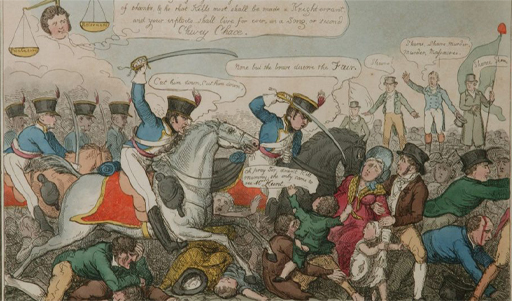6 Social unrest
In the late 1700s and early 1800s, Britain and Ireland were in the grip of a social crisis. Under pressure from the increasing pace of industrialisation and urbanisation, the old order appeared to be breaking down.
During the 1700s, many people moved from the countryside to towns for work. By the 1790s, about 60% of people in Britain and Ireland lived in the countryside and 40% in towns and cities. London was by far the largest city with about one million people, followed by 187,000 in Dublin. There had been rapid population growth over the last 40 years and with more people than there were jobs, wages were low. In Manchester, for example, unemployment was high and the endemic poverty was made worse by poor harvests and (due to the war with France between 1793 and 1802) fewer sales overseas.
Political unrest followed social change. In France, there was a revolution in 1789. Revolutionaries abolished aristocratic titles, called everybody citizen, and ended the practice of slavery in French colonies.
Across the British Isles, ideas spread about the ‘rights of man’. These ideas were dangerous for the ruling elites, given that, in Britain and Ireland, about half the land was owned by just 12,000–13,000 families. It was also possible to buy a variety of influential jobs, including that of MP, which further cemented the inequalities in society.

Rebellion broke out in Ireland in 1798 and there were violent protests by Catholics against the Protestant elite. Nor was such fighting confined to Ireland. Over 200 people died in a week of anti-Catholic rioting in London in June 1780. This involved attacks on metropolitan prisons, including Newgate Gaol, the New Gaol Southwark, the Surrey House of Correction and the Marshalsea prison. Hundreds of prisoners were released by the rioters.
There were riots in Birmingham in 1791 in defence of Church and King. In 1819, a Manchester protest meeting dispersed by armed cavalry resulted in approximately 18 deaths, and over 600 people injured. This last event, Peterloo, rapidly became a symbol of the tyranny of the old order, the fecklessness of the mob and the need for change.
Illiteracy (the inability to read and write), which had been acceptable in traditional, rural societies, began to look out of place and uncivilised in new, urban environments. Industrial employment combined with migration to the towns was stalling the spread of literacy among the lower classes. At the same time, the dissemination of cheap, seditious literature, such as Thomas Paine’s Rights of Man (1791), suggested to the ruling elite that the acquisition and use of the skills of reading and writing needed to be controlled. A growing number of philanthropic individuals and groups sought to combat poverty, radicalism and crime by teaching the poor and prisoners to read and write.
